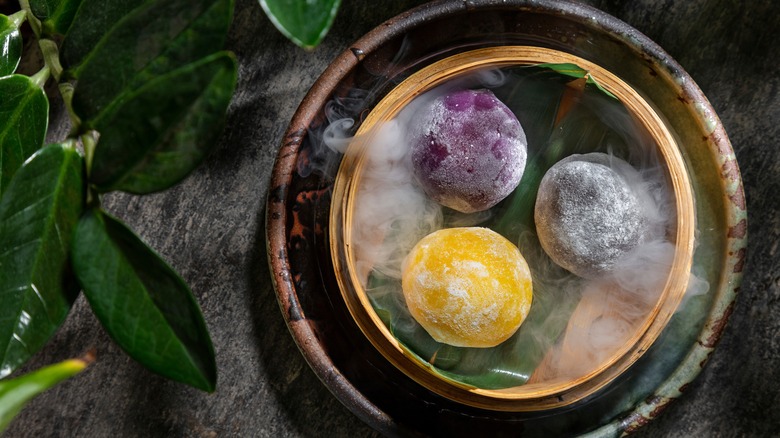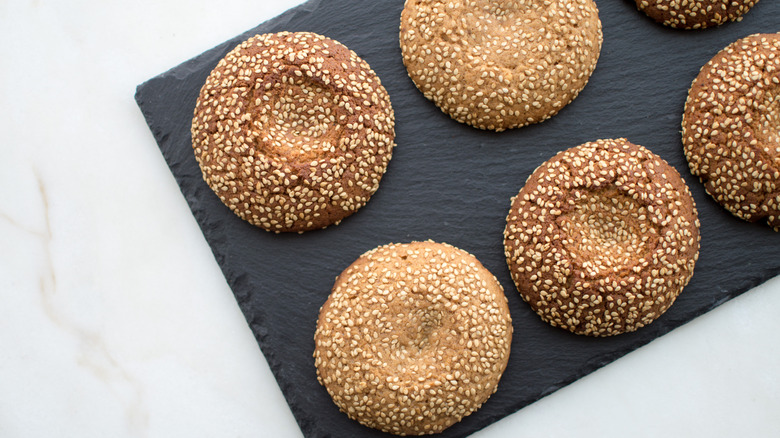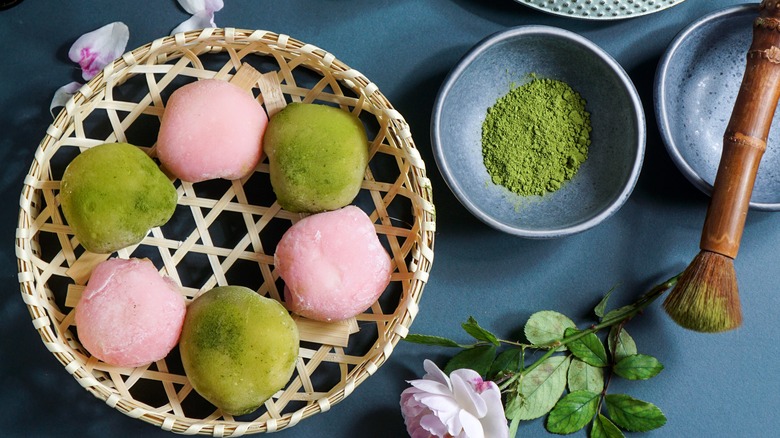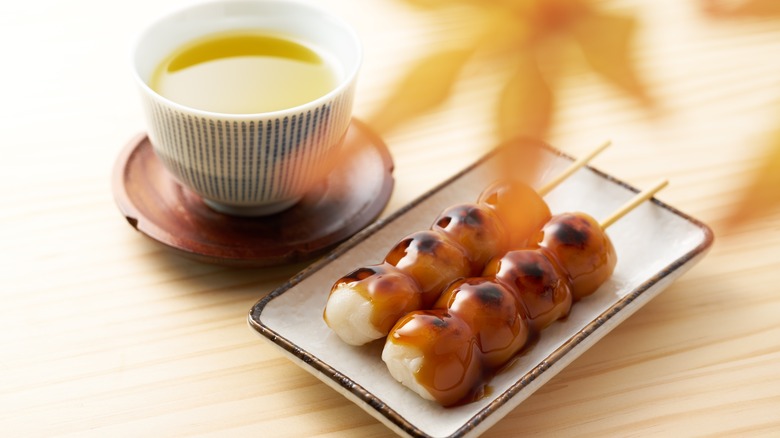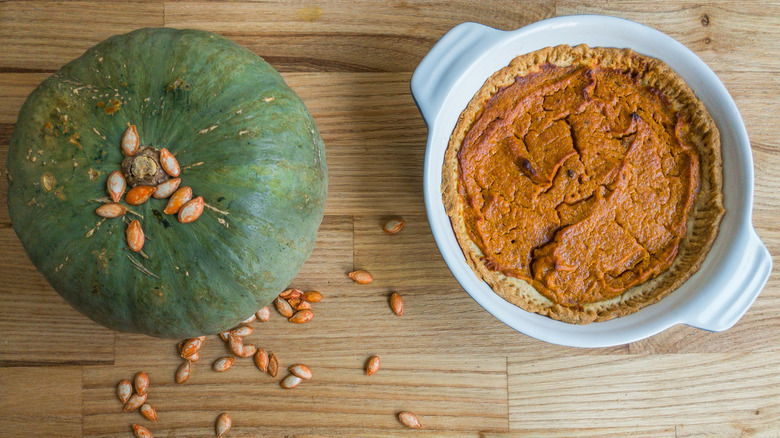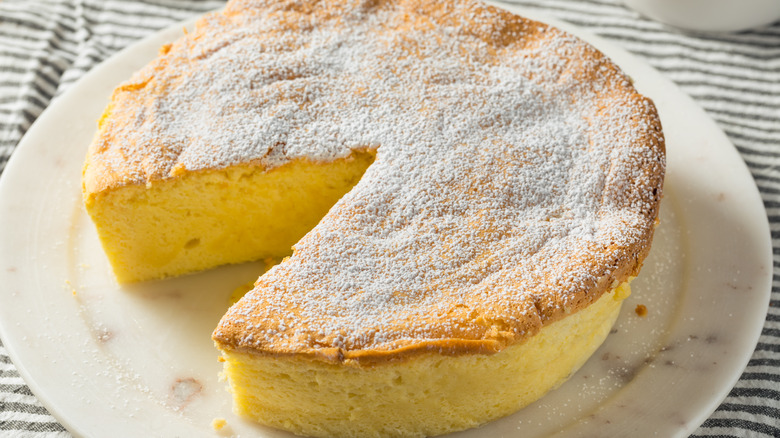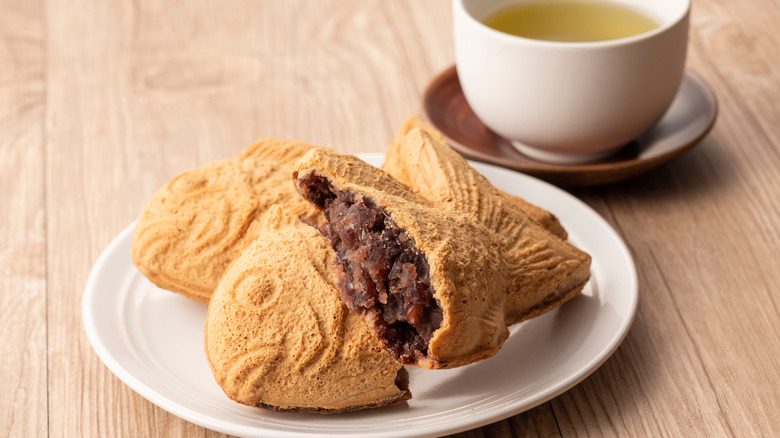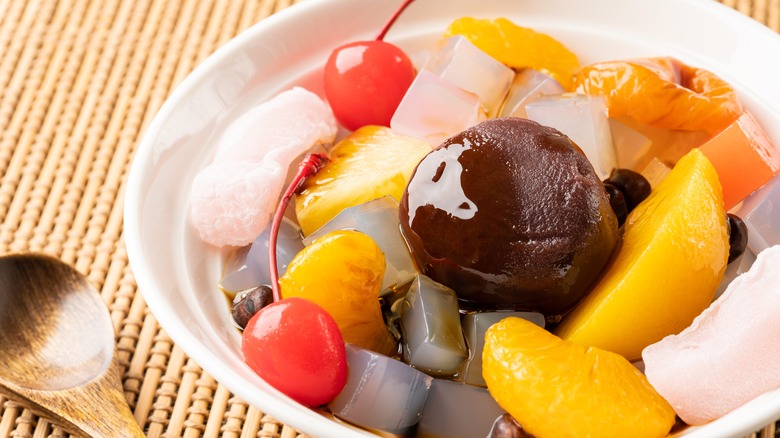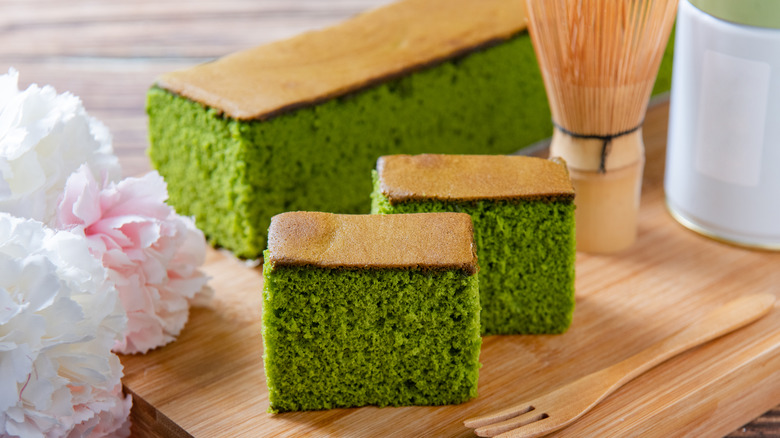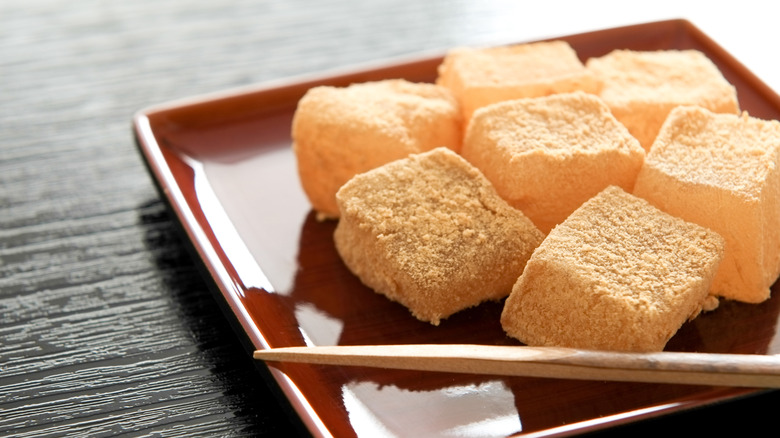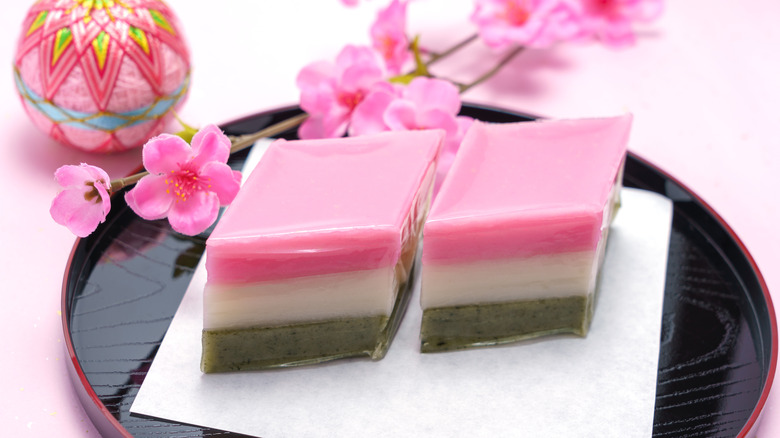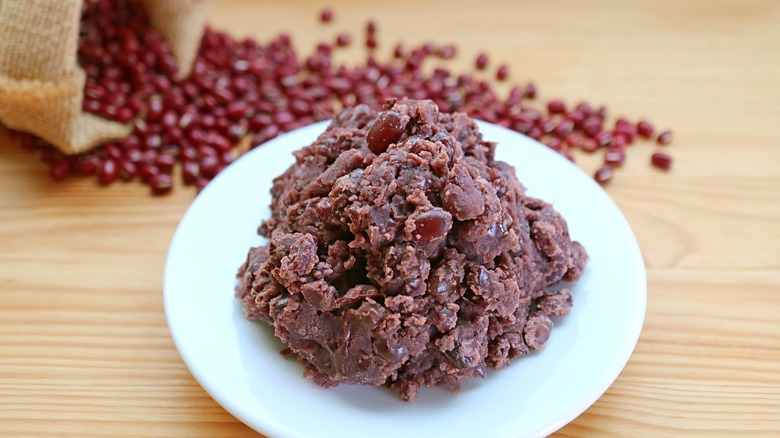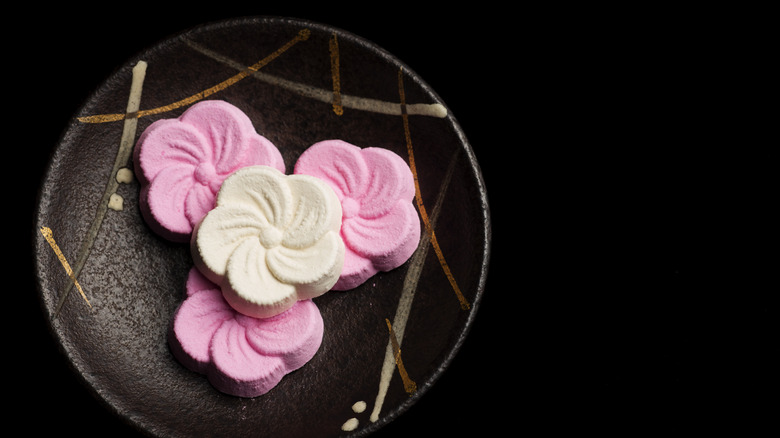12 Japanese Desserts You Should Order If You Get The Chance
Japan's culture and history are full of lavish, bright colors and beautiful art in many forms, and Japanese desserts are no exception. Not only is the presentation of these desserts continually refined and elegant, but the methods for making them tell a tale of their own with unique techniques and tricks.
Desserts are much more than sweet treats in Japanese culture. At times, they are used as a way to mark a period of time or to represent a new season. Finally, they symbolize stories, lessons, and history. A variety of typical and unexpected ingredients are used, such as gelatin and bean paste, to create some favorites.
Three forms of Japanese desserts are often found on the menu, baked or dry, unbaked, and semi-baked. Some of these creations are now readily available in supermarkets and are also prepackaged. Still, a lot of them have a history that originated in small kitchens or has been passed down between generations. It's easy to find some form of mochi or matcha dessert on almost every Japanese menu, as they are the most popular. However, from the oldest recipes to the newest trends, you should know more about these traditional and modern sweet treats that are a big part of Japanese culture.
1. Miso butter cookies
If you've ever been to a Japanese restaurant, they almost certainly had miso soup on the menu. Miso, in general, is a staple of Japanese cuisine that originated in China, made from soybean paste. At one point, miso was so valuable that it was used as currency. Today, this common ingredient in Japanese cuisine is found in many dishes and desserts, such as miso butter cookies.
Miso butter cookies have a dry, shortbread-type texture and can be similar to crispier peanut butter cookies. The amount of miso is relatively small, usually about 2 to 3 tablespoons. This can seem like a lot considering the strong flavor of miso. However, during the baking process, the miso flavor becomes mild and earthy. It often helps cut through the sugary taste, and the final result is more of a biscuit-like cookie. These cookies are typically small, round, and sprinkled with either black or white sesame seeds. The seeds are mild in flavor and serve more as decoration, although they provide a nice crunch.
2. Mochi
This prominent Japanese dessert is a fluffy, chewy dough made of rice flour that is eventually formed into small dumpling shapes. Inside, the fillings can range from bean paste or matcha to peanut butter and can even be savory at times. Carefully shaping the dough and sealing the filling inside by hand is a difficult skill and usually takes hours of practice before perfecting. Mastering the handmade treat is an example of how food in Japanese culture can be an art form. This technique is passed down through families and practiced to achieve that perfect dome-shaped dessert.
Mochi is often enjoyed as a sugary snack because of the many layers of sweet flavors. The dessert is also traditionally enjoyed on the Japanese New Year as it is believed to bring good luck in the upcoming months to help fend off the remaining cold winter ahead.
The true form of mochi has undergone a serious transformation — it was once eaten with soup and vegetables and enjoyed as a savory meal. Mochi is traditionally round in shape, though a flat, circular version does often appear on Japanese New Year. The dessert comes in many forms and flavors and has recently been made more accessible to shoppers. For example, mochi ice cream can be found in the frozen aisle of several grocery stores.
3. Dango
Dango is similar in shape to mochi and is also made from rice flour dough. The main difference is that they are served on bamboo sticks and are drizzled or covered with sauce. Typically, they appear with four or five dough balls that are meant to represent the head of a person, their two arms, and two legs. The colors are usually red, green, and white, but many other colors appear on menus and in kitchens all over.
To make dango, the dough is mixed, kneaded, and formed into small globes that can fit on a long stick. The dough balls are then boiled for a short time, transferred to a pot of ice water, and then grilled. The last remaining step is to slather the dessert in a sauce that is usually a mixture of soy sauce, mirin (rice wine), sugar, and water. This dessert, like mochi, is believed to bring good fortune to those who eat it. However, they've also been used as an offering to the gods and goddesses in Japanese culture, presented upon entering a shrine.
4. Kabocha squash pie
Kabocha squash pie is the Japanese version of pumpkin pie and resembles the fall treat quite a bit. From the warm, flaky crust to the orange filling, this pie is often enjoyed around the time of the winter solstice. According to Nourish by WebMD, the vegetable has nutritional value, is quite flavorful, and is believed to boost your immune system during the long winter months.
Japan was introduced to the kabocha squash by Portuguese sailors, and the fruit quickly grew in popularity, which is why it is now often referred to as a Japanese pumpkin. The winter squash has a green rind, but the meat is similar to pumpkins in color. However, the natural flavor is far sweeter, which makes cooking kabocha squash perfect for pies — though it is also served in soups.
Kabocha squash is packed with vitamins and is a great source of fiber, zinc, and iron. Best of all, the natural sweetness of the squash means that less sugar is required for kombucha squash pie than what's typically used in a pumpkin pie recipe. Though this is a common dessert in Japan, it has also become a great alternative on Thanksgiving Day in America. The natural flavor of the squash is said to make a much lighter filling with a fresher taste. To make a pie, the inside of the squash is steamed and pureed. Adding in spices, such as cinnamon, ginger, nutmeg, and cloves, brings out the nutty flavor and makes a hearty dessert.
5. Japanese cheesecake
The iconic cheesecake is relatively new to the Japanese dessert scene. Japanese cheesecake is uniquely a cross between American cheesecake with thick yet spreadable cream cheese and German cheesecake, which is made from a yogurt-like ingredient. Both have delectable qualities, though neither is as fluffy and soft as Japanese cheesecake.
This dessert can be traced back to one man in postwar Japan, Chef Tomotaro Kuzuno. In the 1960s, he traveled to Berlin and was so intrigued by the various types of cheesecakes that he experimented with combinations until settling on a recipe of his own. The difference is that the cake has less sugar, and the egg whites and yolks are beaten separately and then mixed together. This is why the final product resembles a soufflé. A Japanese cheesecake famously rises into a mound that is light, airy, and undeniably jiggles.
The delicate cheesecake is not too sweet, which is why it's often served with a choice of toppings. A layer of powdered sugar is always a must, and other toppings like strawberry sauce, whipped cream, and fresh fruit are common additions. Japanese cheesecake is made with everyday ingredients and baked in a springform pan, so you likely have everything you need to make this dessert right now.
6. Taiyaki
Taiyaki is a fresh take on a common Japanese treat called imagawayaki. They are both cake-like pastries with some kind of filling inside, usually red bean paste. The biggest difference is that taiyaki is cooked in a mold of a decorative red sea bream fish. The red sea bream fish used to be considered a delicacy that was mainly enjoyed by the upper class. Molding typical ingredients into such an image of status made the symbol available to people of all classes. The dessert is quite common now in shops and can be found all throughout the streets during festivals and other celebrations.
This dessert's cake-like outside is made from common ingredients and is often compared to the taste and texture of a waffle. Although there are variations of the dough, most of it remains mild in flavor and somewhere between savory and sweet. This means that chefs and bakers have gotten very creative with filling ideas. Traditional red bean paste typically has an earthy, almost sweet potato-like flavor that is enhanced with sugar and other spices. However, it's not uncommon to find taiyaki with chocolate, custards, and other creamy sweet fillings. Some chefs even serve savory versions similar to dumplings with fillings like pork, cabbage, curry, and other meats.
7. Anmitsu
This colorful dessert is a combination of popular Japanese ingredients and is often served in a large bowl with a side of syrup. Anmitsu is typically made up of agar agar jelly, red bean paste, mochi, ice cream, boiled red beans, and a variety of fruits. Agar agar jelly is made from sea algae and solidifies into soft, clear jelly. The jelly doesn't have much natural taste and typically absorbs the flavors of whatever it is served with. As the publication mentions, you can get creative with a load of other ingredients like ice cream and fruit. On top, some form of syrup can be drizzled, or brown sugar can be sprinkled over the bowl.
The treat is often compared to a parfait or type of fruit salad because of its texture and appearance. Mixing colorful elements is part of the fun of anmitsu, and it offers plenty of opportunities to think outside the box. Once upon a time, if this sweet dish was on the menu, it was a sure sign that the weather was warming up and the summer season was on the horizon. However, it is now served year-round and is standard on Japanese restaurant menus.
8. Matcha cake
The bright green powdered tea that is matcha can be found in several Japanese recipes, such as teas, smoothies, ice cream, cookies, cakes, and more. Matcha is packed with nutrients and is not only enjoyed for its flavor but for its health benefits. So, why are we raving about matcha? Well, it is typically found in a few variations of matcha cake.
The dessert is often mixed with other dry ingredients, giving most recipes an added fresh taste and vibrant green color. However, the most common matcha cakes are crepe cakes, roll cakes, and a type of sponge cake called matcha castella.
Matcha sponge cakes and roll cakes are similar types of dense cakes that are firm on the outside and softer near the middle. Crepe cakes are a stack of crepe layers with some kind of cream in between to create a decadent and moist layer cake. High-quality matcha is often enjoyed as fresh tea and is used throughout Japanese tea ceremonies, while lower quality matcha is best used for baking.
9. Warabi mochi
Warabi mochi is not a mochi flavor. This dessert is quite different from regular mochi. For starters, mochi is chewy, whereas warabi mochi is more jelly-like and isn't filled with anything. Jello-like squares are made from the starch of bracken root, cut into cubes, layered in soybean flour, and served with brown sugar syrup. The result looks similar to stained glass candy, but the texture is entirely different. Warabi mochi distinctly wiggles and can be served cold with a side of ice cream.
To make warabi mochi, the starch from the bracken root is mixed with sugar and water and heated in a saucepan until a sticky sort of batter forms. The mixture is then poured into ice-cold water, making it firmer and more malleable. After being shaped into cubes or small balls, the jello is strained and coated in soybean flour that has a bitter, nutty flavor. Simple brown sugar syrup is then drizzled over the top to be enjoyed. Although the original recipe calls for warabi starch, you can also use sweet potato starch to achieve a similar result.
10. Hishi mochi
Another take on mochi is hishi mochi, which is made and eaten on Hinamatsuri, or Girl's Day, an annual Japanese festival. Hishi mochi is almost always made in three layers and is pink, green, and white in color and has the same sticky, chewy texture, and sweet flavor.
The mochi is cut into rhomboid shapes to represent fertility and prosperity. The colors are a symbol of good health, while the layers tend to be red or pink, white, and green — in that order. The red layer is made with cape jasmine, the white layer uses water caltrop, and the green is flavored with mugwort.
Hinamatsuri honors each of the young girls in each family and is celebrated throughout the years until they reach adulthood. The day is full of food, sweets, and some events at shrines take place. Traditional Japanese dolls are placed around the shrines, and hishi mochi is typically offered to the dolls to bring about prosperity and good fortune to young girls.
11. Anko
Anko is not often served alone, but it is a major component of many other Japanese desserts. Anko is a red bean paste that can range from sweet to savory but tends to be a dessert-like treat. The mixture is frequently used as a filling for mochi or taiyaki in its many different forms.
Anko originally made its way to Japan from China when Buddhist monks were seeking a meatless alternative to some dishes. Anko was not always sweetened and used in desserts. Adding salt to the mixture made it savory and went well with vegetables and even meats.
The texture of anko can vary greatly. In fact, there are multiple forms of red bean paste with varying textures based on how long the beans are cooked and if the skin is removed before making it. The flavor will also vary, as the beans tend to be mild and can take on the flavors of other ingredients.
12. Higashi
This dessert is often a decorative, fun addition to a cup of tea in Japan. Higashi is a Japanese treat that is made of sugar, rice flour, and at most 10% of moisture. The natural flavor is mildly sweet, which makes it the ideal treat without overpowering the pallet.
Higashi is made from wasanbon sugar, which is refined several times and considered a very high-quality product. Wasanbon sugar is harvested from chikusha sugar cane found on Shikoku Island. Harvesting the sugar involves several steps and takes about 20 days to complete. Once the sugar is harvested, it can be pressed into any number of molds including musical themes, flowers, cartoon characters, famous statues, and more.
The possibilities for higashi molds are endless, but they are often cheery and whimsical. The molded sugar looks beautiful on display and can be eaten as candy or can be mixed into drinks, such as tea or coffee as a sweetener. This treat is just another example of how Japanese cuisine can be its own form of art.
